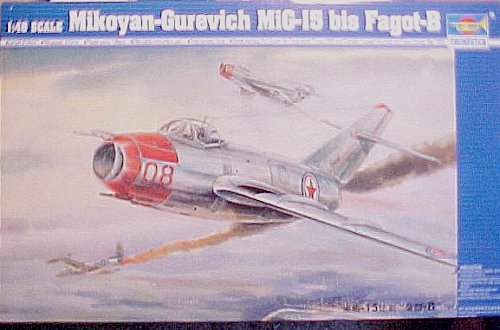
|
KIT: |
Trumpeter 1/48 Mig-15bis |
|
KIT # |
? |
|
PRICE: |
$28.98 |
|
DECALS: |
2 Aircraft |
|
REVIEWER: |
|
|
NOTES: |

|
HISTORY |
The MiG-15 was a nightmare come true for the United States Air Force in the fall of 1950: a Soviet jet fighter that outperformed all U.S. fighters then operational in the Korean War. While it's true that history's first jet vs. jet combat, which involved a Lockheed F-80C Shooting Star flown by Lt. Russell Brown of the 51st Fighter Interceptor Wing and a MiG-15 that was likely flown by a Russian "volunteer" ended in victory for the Shooting Star, it was luck and individual pilot ability - not superior technology -that was responsible for that feat. Those little aluminum dots over the Yalu with their swept wings sent a shiver of fear through every American flyer in Korea.
That December of 1950, the 4th Fighter Interceptor Wing - descendants of the American Eagles of the RAF and the top-scoring U.S. fighter group of World War II - arrived in-theater, equipped with the most advanced U.S. fighter, the superb North American F-86A "Sabre." By the middle of the month, it had been established that the Sabre could take on the MiG-15 with confidence both from equipment and flying ability of the pilot. The next two and a half years would see air battles between outnumbered Sabres and MiG-15s over "Mig Alley," which was basically the northeastern quarter of North Korea from just north of the capital at Pyongyang to the Yalu River. It was not until 1 December 1951 that Sabre strength would multiply when the 51st FIW flew their first missions with the F-86E Sabres (Thanks to Keith Fannon, 51st FIW Historian for the correct dates). They joined the 4th Fighter Wing in their lonely battle against the MiGs.
The MiG-15 was not a dog-fighter. Its heavy cannon armament was designed to blow apart a B-36 over the Soviet Union at 45-50,000 feet, in the first pass. While the Sabres proved their superiority over the MiG-15 when it was flown by Chinese and North Korean pilots, when the U.S. fighter went up against MiG-15s manned by Russians who were also veteran aces of the Second World War - as were many U.S. Sabre pilots - it was a different kettle of fish. The Russians of the 324th IAD - the first unit to enter combat in late 1950 - were commanded by no less that COL GEN Ivan Kozhedub, who - with 62 victories - was the Allied Ace of Aces of the Second World War; in fact, we now know that the Ace of Aces of the Korean War was not 16-victory ace Captain Joseph McConnell of the 51st FIW, but rather COL Yevgeny Pepelyaev, CO of the 196th Guards Fighter Regiment, a fierce believer in the adage "train hard, fight easy" who strove "to meet the American standard" with his pilots. During his 6-month tour in 1951, Peplyaev claimed 23 of the 104 victories scored by the 196th IAP.
Sergei Komarenko, a 13-victory Soviet ace (on top of 12 WW2 victories) described combat between Sabres and MiGs thus: "The Sabre was the most dangerous threat to my friends and I in Korean skies. Our MiG-15 and the Sabre belonged in the same class, similar types with similar performance. They differed only in that the MiG had an advantage in rate of climb at altitude, while the Sabre was superior in maneuvering, especially at lower levels. The fight, as a rule, was decided in the first attack. After the first pass, we reached for altitude, while the Sabres rushed for the ground. Each tried to reach an altitude where it held a distinct advantage, and thus the battle faded."
Revised figures place USAF claims against the MiG-15 at 375, with admitted F-86 losses of 103, giving a 3.5:1 kill ratio. This is lower than the wartime claim of 10:1, but still very respectable.
|
THE KIT |
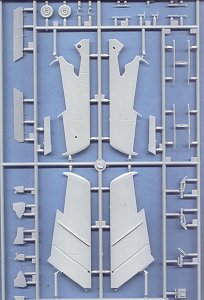 |
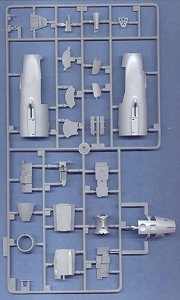 |
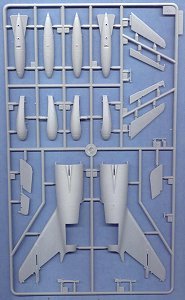 |
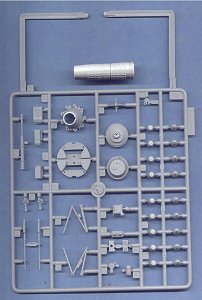 |
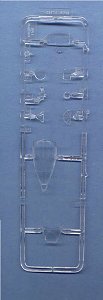 |
This kit by Trumpeter is the fourth attempt at getting the famous MiG-15 right in 1/48 scale. The first, by Hawk in the late 1950s/early 1960s, is of little interest today other than to kit collectors, being nothing more than "vaguely" a MiG-15. The second - which appeared in 1975 - was for 20 years the best MiG-15 available in 1/48; unfortunately, Monogram managed to do their kit in a scale more like 1/40, making the diminutive Soviet interceptor as big as its F-86 opponent - the first time I saw a real MiG-15 sitting next to an F-86 out at Chino in the mid-80s, I knew something was wrong. Tamiya brought out their MiG-15 in 1995, and got the airplane about 80 percent right. Unfortunately, they missed with their wing in exactly the same way Hasegawa missed with the wing of the their F-86 Sabre: the leading edge was swept at 35 degrees, rather than the correct 35 degree sweep on the main spar at 20 percent of chord.
I have to admit, I did not rush out to get this kit on first arrival, having made their sadly-lacking 1/32 scale attempt a few years ago for display at Planes of Fame. That kit is a simple pantograph of the Tamiya MiG-15, with all its faults and a few original mistakes by Trumpeter thrown in for free. The plastic is pebbly, the canopy misshapen, the cockpit a joke in 1/72 scale, let alone 1/32. None of these problems exist with the new kit.
For starters, the Trumpeter kit's plastic is as good as that used by any mainstream manufacturer, and the molds are sharp and clean, with the result being good smooth, shiny plastic parts. Additionally, the wings, horizontal stabilizers and vertical fin are all swept at the correct angles. This appears to be the most-accurate MiG-15 now available.
The kit-supplied cockpit makes up into a more detailed sub-assembly than does the Tamiya kit. Both will look better with a resin cockpit like the ones made by the Czech firm Ciro and imported by Linden Hill, but this will also be acceptable as an OOB model. Unlike the Tamiya kit, it includes the glass head armor that was fitted inside the canopy.
The rest of the detail also appears superior to Tamiya's kit. The three cannons are a separate sub-assembly that allow the gun bay to be displayed open. The avionics bay immediately in front of the cockpit can also be displayed open. The RD-45 (Nene) engine is far more detailed than that in the Tamiya kit, offering twice as many parts for its assembly. Just looking at the fuselage assembly, it appears that the rear fuselage of this kit could be installed without being glued in place, so that the model can be displayed with the engine visible or not - this is not something you can do easily with the Tamiya kit. (Your editor would like to point out that on his Tamiya Mig-15, the aft fuselage was not glued in place and it was a very tight fit.)
The landing gear, wheel wells and landing gear doors have nicer detail than the equivalent parts of the Tamiya kit. The seat will look more acceptable with seatbelts. The canopy should be quite clear if it is dipped in Future.
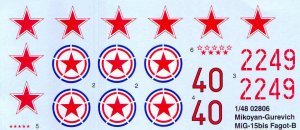 My
only real complaint is the instrument panel. This is done as a "sandwich" of an
opaque part, with a photo-print panel like an Eduard kit, and a clear part to go
over it - the problem is that the clear part has no engravings for the
instruments, which will make painting around the instruments a bit difficult. I
am sure I will make my own panel to go over the photo-print from .010 Evergreen
sheet.
My
only real complaint is the instrument panel. This is done as a "sandwich" of an
opaque part, with a photo-print panel like an Eduard kit, and a clear part to go
over it - the problem is that the clear part has no engravings for the
instruments, which will make painting around the instruments a bit difficult. I
am sure I will make my own panel to go over the photo-print from .010 Evergreen
sheet.
Decals are provided for one camouflaged Soviet MiG-15 and one NMF-finish aircraft in North Korean markings which the kit instructions identify as the airplane flown by Captain "Wang-hai" of the Chinese People's Volunteer Air Force in Korea in 1953.
|
CONCLUSIONS |
This kit appears to be an excellent value, with more detail and accuracy at a cheaper price than the Tamiya kit. (Actually, the Tamiya Mig-15 retails at $27.00, according to the 2002 Squadron Catalogue, which would make it a tad cheaper. Ed). However, all is not as rosy as it appears. When undergoing assembly of this kit, I found all of the fit problems and other hassles of the larger 1/32 kit. Enough so that this kit ended up in the circular file (trash). It just goes to show that what looks good in the box does not always build well. Based on this experience, I suggest you pass on this one.
A BIT OF RESEARCH FOR YOU ALL:
For those of you planning to do your MiG-15 in a natural metal finish, here is a photo I took of the Mig-15 owned by The Air Museum, "Planes of Fame," which is kept in a "natural" natural metal finish, i.e., it isn't polished or anything, though it is hangared and kept clean. This was a good bright day for air-to-air photography and you can easily see the different shades of metal involved.

If you would like your product reviewed fairly and quickly by a site that has well over 150,000 visitors a month, please contact me or see other details in the Note to Contributors.